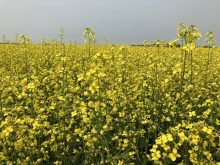REGINA — Farm organizations warn that Canada should be cautious about introducing carbon border adjustment mechanisms for agriculture.
The mechanisms are a way to account for emissions contained in imported products. They aim to prevent carbon leakage by applying a levy to products if they don’t meet certain standards.
The farm groups told the standing agriculture committee, which is now studying the issue, that such measures would only work if they were part of a multilateral effort. Agriculture and agri-food are too complex, they said.
Read Also

Bunge’s crop mix is changing
Bunge has predominantly been a soybean processing firm, but that’s about to change after the merger with Viterra with softseed processing and grain merchandising gaining ground.
Committee chair Kody Blois said the committee undertook the study because other countries are implementing carbon border mechanisms, not because Canada has plans to do so. So far agricultural products have not been included but Canada, as a large exporter, is watching.
The European Union has transitional mechanisms in place on industries such as steel, aluminum and fertilizer and has plans to introduce more. The mechanisms are to be fully in place by Jan. 1, 2026.
The United Kingdom has said it will have a carbon border adjustment mechanism in place in 2027, and other countries are considering them. There are bills before the United States Congress and a task force is considering them as well.
The managing director of the Canadian Agri-Food Policy Institute told the committee during recent hearings that he doubts these will be in place for the food system anytime soon.
“While the EU is moving ahead with BCAs (border carbon adjustments), the coverage is limited to six emission-intense trade-exposed products that are covered under their EU emissions trading systems (ETS),” Tyler McCann said.
“Agriculture production is not covered by the EU ETS and there is no serious dialogue that it would be covered by the ETS or the BCA.”
He said the EU deforestation regulations, to ban imports of products from deforested land, are a greater challenge to agriculture than a theoretical border adjustment.
The Canadian Agri-Food Trade Alliance said sustainability measures should not become barriers to free and fair trade.
Executive director Michael Harvey said most agricultural trade occurs under World Trade Organization rules and that’s best.
“If that’s not possible, like-minded partners, sometimes groups like the G7, can be places to multi-lateralize preliminary solutions,” he said. “However, when things aren’t decided at the WTO, almost inevitably you’re going to have patchwork rules and that’s problematic.”
Canada’s carbon tax is a factor in the discussion. Blois called it the elephant in the room.
But the country’s low greenhouse gas emissions from agriculture compared to the rest of the world were also noted.
“How do we make sure that Canadian superiority on some of these products is actually accounted for?” Blois said, adding competitiveness of Canadian producers is a concern.
Canada consulted on carbon border adjustments in 2021. Michele Govier, director general of the international trade policy division in the finance department, said agricultural stakeholders participated and provided mixed and cautious support for adjustments.
“There was recognition that carbon sources and costs in the agriculture sector are more complex and would not lend themselves well to carbon accounting associated with a BCA,” she said.
They recommended upfront relief of carbon pricing to ensure competitiveness and expressed concern that carbon adjustments could affect farm input costs.
The International Institute for Sustainable Development in an analysis posted Oct. 8 said the EU’s implementation of carbon border adjustment mechanisms is “running ahead of our understanding of how it should fit into the complicated puzzle of international economic and environmental governance.”
The IISD said international co-operation is urgently needed to avoid a “spaghetti bowl” of different requirements, compliance costs and trade friction.
















